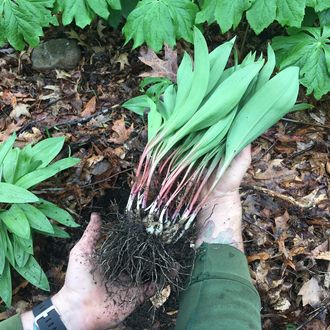
It’s hard to grow ramps. It’s actually sort of impossible, the thinking goes. Ramp haters — of which there seem to be more each year — will say that ramps are little more than glorified scallions, but the main difference, and the reason so many chefs celebrate ramps’ springtime arrival and their very short growing season, is that ramps cannot be cultivated or grown through traditional farming techniques. Like exotic mushrooms and the finest Nordic herbs, ramps must be sought out and carefully foraged in the wild, usually in forests or near gently babbling streams. Or, as it turns out, in Brooklyn.
In fact, there are ramps growing at the Brooklyn Botanic Garden, and they were cultivated by Uli Lorimer, the curator of the BBG’s Native Flora Garden. It’s something of an agricultural miracle: In 2005, Lorimer found a small patch of ramps in the garden growing along a small ridge. Being a good botanist, he decided to try to grow more.
In late summer 2008, after the leaves of the ramp had wilted and died, the bulb sent up its flower stalk and seed-filled flower. Lorimer sowed the seeds that autumn in the garden’s outdoor nursery, and after two years, they eventually reached a size large enough for transplanting. Lorimer then divided the seedlings into 12 clumps and planted them along the same ridge, then “let nature take its course.” Since then, the colony has grown on its own, and, all told, it took the better part of a decade for the ramps to reach a point where they’re similar in size to the ones that show up at the farmers’ market for $5 per bunch. Clumps have even appeared in other parts of the garden, thanks to natural dispersal. “They’ve been happy here. They’ve flowered and reproduced,” Lorimer says. “Maybe in another eight years, it will be a solid patch. As long as no one comes and harvests them.”
But that’s exactly what happened: At some point, someone stole some of the garden’s cultivated ramps.
“I always get anxious this time of year,” Lorimer says, pointing to a hole in the ground where ramps once lived. A sign identifying them by another name, “wild leeks,” did not deter the thief — or thieves — and the sign, like the ramps, has since been removed entirely. In many ways, the theft is a reminder why foragers — the people who make their livings by finding wild edibles and supplying them to chefs and cooks — are so intensely secretive, fearing that anyone can come along to claim, and perhaps incorrectly harvest, otherwise-valuable ingredients. (That’s a concern for Lorimer, too: “It distresses me,” he says of improper foraging techniques, “that people can come and rip them out.”)
Lorimer didn’t call the police after discovering the theft, but he did file an internal report with garden authorities, so there would be a paper trail, he said. No leads have turned up, and as of now, ramp-security cameras haven’t been installed — yet.
Lorimer actually isn’t too worried, since the theft didn’t deplete the entire supply, and he’s not planning to make any changes to protect future bunches, either. He’s going to let them do their thing, and is planning to cultivate a new crop soon. But at least one Brooklyn-based ramp enthusiast has a thought: “That’s so verboten in the garden — that’s terrible!” said chef Rob Newton when he heard about the theft, adding, “He’s gotta put up a guard dog.”




